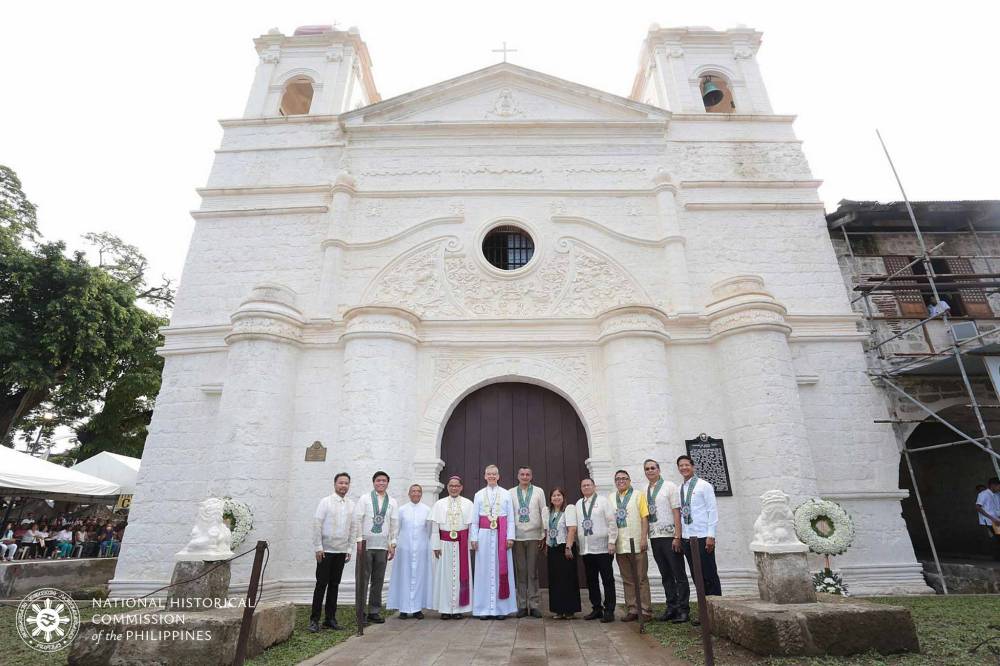On June 20, the National Museum of the Philippines (NMP) and the National Historical Commission of the Philippines (NHCP) unveiled the historical and cultural markers of the newly restored Caysasay Church, also known as the Archdiocesan Shrine of Our Lady of Caysasay in Taal, Batangas.
In the same event, the marker of the decree of its dedication as an archdiocesan shrine was also unveiled, after which a eucharistic celebration with the solemn dedication of the church and the altar was presided over by Papal Nuncio to the Philippines Archbishop Charles Brown and Lipa Archbishop Gilbert Garcera.
NMP had declared the church, and the nearby Santa Lucia well and Hagdan-hagdan collectively, as National Cultural Treasure in 2020, while the NHCP declared the church a National Historical Landmark in 2024.
It was damaged by the Taal Volcano eruption on Jan. 12, 2020, and the following year, the NMP initiated its restoration and rehabilitation, which also included the Santa Lucia well.
The restoration of the church was concluded this year, with interior paintings by Guy Custodio’s team and stations of the cross donated by the Villavicencio family.

Raul Martinez, director of the shrine, said during the program that they’re “in high spirits for this once-in-a-lifetime event,” which he said is “one for the record in the entirety of this shrine’s history.”
NMP director general Jeremy Barns said also during the program that his agency and other stakeholders involved in the project take in great pride the the fruit of their labors.
“The National Museum took up the task of leading the government response toward the urgent repair and restoration of this heritage site that, as a National Cultural Treasure and National Historical Landmark, is outstanding for cultural, historical, and of course, religious reasons,” he said.
Exemplary model
He explained that so far, this is the best restoration done by his agency, and it is an “exemplary model of restoration of a Filipino heritage church that we can be proud of” and which could inspire other restoration projects.
He said this is the best in terms of art, architecture and modern safety standards which were applied to the church.
NHCP executive director Carminda Arevalo, meanwhile, described the church as “one of the celebrated religious sites in the Philippines,” and her agency is proud to present the historical marker.
She said the church’s restoration “symbolizes our continued cooperation to protect, preserve sites and structures of historical and cultural significance.”
One of the church’s significant features is the beautiful bas relief on its façade, which was discovered while the portico, which was added in the 19th century, was being removed.
Featuring floral designs with the Augustinian seal at the center, the style, according to Barns, could date back to the 17th century, perhaps in 1639, when the stone church was erected to replace the one built from light materials in 1611.
The central portion of the façade is also identical to the design of the Santa Lucia well.
In his lecture in March last year at the “Binalot Talks “of the University of the Philippines–School of Archeology, church historian Regalado Trota Jose said the church, made from coral stone and adobe, floated the idea that the church was built at an ancient sacred site.
He said that it cut through an adobe mound, or perhaps a cave used by ancient residents of the area as a hallowed ground.He said that bulk of the church was built in the first decade of the 18th century, and that by 1719, the church and convent were already up.
In 1754, its roof and portions of the wall collapsed as a result of Taal’s most famous eruption.
Forty-six years later, the transept, dome and two towers were added to the church, but the latter fell during the 1852 earthquake and was subsequently rebuilt.
Miraculous image
As for the Santa Lucia well, this might also have been built in the first quarter of the 18th century, while the steps connecting Caysasay to Taal población above was built in the 19th century.
The church houses the miraculous image of Our Lady of Caysasay, which was fished out of the lake in 1603.
While the church’s restoration and rehabilitation were ongoing, a well was discovered in front of the façade as well as small canals around the church.
The purpose and the reason for the placement of the former remains a mystery.
Apart from these, the wooden trusses, believed to have been installed in the 19th century, the previously known date for the construction of the church, were also discovered to be older.
Barns said these were the trusses built after the roof collapsed during Taal Volcano’s 1754 eruption.
Also discovered were carved stone bases for saints and remnants of what used to be a Holy Family image.
Barns explained that the restoration of the church boosts the nomination of the Taal geographic area to the World Heritage List of the United Nations Educational Scientific and Cultural Organization (Unesco).
The Historic Towns and Landscape of Taal Volcano and its Caldera Lake are now among seven new natural and cultural properties added to the country’s World Heritage Tentative List.
In the Unesco dossier, it notes that the towns “demonstrate the blending of different cultures as a result of colonization in architecture and urban planning.” —CONTRIBUTED INQ